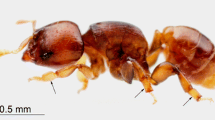Summary
This paper reports the results of the first detailed study of the morphology of exocrine glands in two species of the ant subfamily Leptanillinae. Workers of Leptanilla escheri and L. japonica possess a large, unpaired sternal gland in the VIIth abdominal sternite, and an hypertrophied poison gland which is surrounded by a massive muscle layer. The sternal gland is absent in the queen of L. japonica, and the poison gland is highly degenerated. The queen is, however, endowed with a series of large, paired, intersegmental tergal and sternal glands, which occur between the IVth through the VIIth segments. The queen also posseses large spiracular plate glands.
Similar content being viewed by others
References
Baroni Urbani C (1977) Materiali per una revisione della sottofamiglia Leptanillinae Emery (Hymenoptera: Formicidae). Entomologica Basiliensia 2:427–488
Billen J (1985) Ultrastructure de la glande de Pavan chez Dolichoderus quadripunctatus (L.) (Hymenoptera: Formicidae). Actes des Colloques Insectes Sociaux 2:87–95
Burns W, Bretschneider A (1981) Thin is in. American Society of Clinical Pathologists, Educational Products Division, Chicago, pp 19–20
Buschinger A, Maschwitz U (1984) Defensive behavior and defensive mechanisms in ants. In H.R. Hermann, ed., Defensive Mechanisms in Social Insects. Praeger, New York, pp 95–150
Fanfani A, Dazzini Valcurone M (1986) Glandole delle ponerine e richerche sulle glandole del gastro di Megaponera foetens (Fabr.) (Hymenoptera: Formicidae). Accademia Nazionale dei Lincei 383:115–132
Franks N, Hölldobler B (1987) Sexual competition during colony reproduction in army ants. Biological Journal of the Linnean Society 30:229–243
Gurr E (1956) The Practical Manual of Medical and Biological Staining Techniques. Interscience Publishers, Inc., New York
Hölldobler B (1984) Communication during foraging and nest relocation in the African stink ant, Paltothyreus tarsatus Fabr. (Hymenoptera, Formicidae, Ponerinae). Z Tierpsychol 65:40–52
Hölldobler B, Engel H (1978) Tergal and sternal glands in ants. Psyche 85:285–330
Hölldobler B, Engel H, Taylor W (1982) A new sternal gland in ants and its function in chemical communication. Naturwissenschaften 69:90
Jessen K, Maschwitz U (1983) Abdominaldrüsen bei Pachycondyla tridentata (Smith): Formicidae, Ponerinae. Insects Sociaux 30:123–133
Jessen K, Maschwitz U, Hahn M (1979) Neue Abdominaldrüsen bei Ameisen I. Ponerini (Formicidae: Ponerinae) Zoomorphology 94:49–66
Mascorro J, Ladd MW, Yates RD (1976) Rapid infiltration of biological tissues utilizing n-hexenyl succinic anhydride (HSXA/vinyl cyclohexene dioxide (VCD), an ultra-low viscosity embedding medium. 34th Annual Proceedings Electron Microscopy Society of America, 346
Masuko K (1987) Leptanilla japonica: the first bionomic information on the enigmatic ant subfamily Leptanillinae. In: Eder, J. and H. Rembold (eds), Chemistry and Biology of Social Insects pp. 597–598, J. Peperny, Munich
Oliveira L, Burns A, Bisalputra T, Yang K (1983) The use of an ultra-low viscosity medium (VCD/HXSA) in the rapid embedding of plant cells for electron microscopy. J Microsc 132(2):195–202
Ruddell C (1971) Embedding media for 1–2 micron sectioning. 3. hydroxyethyl methacrylate benzoyl peroxide activated by pyridine. Stain Technology 46(2):77–83
Traniello JFA, Jayasuriya AK (1981) Chemical communication in the primitive ant Aneuretus simoni: the role of the pygidial and sternal glands. J Chem Ecol 7:1023–1033
Wilson EO (1971) The Insect Societies. Belknap Press of Harvard University Press, Cambridge, Massachusetts
Author information
Authors and Affiliations
Rights and permissions
About this article
Cite this article
Hölldobler, B., Palmer, J.M., Masuko, K. et al. New exocrine glands in the legionary ants of the genus Leptanilla (Hymenoptera, Formicidae, Leptanillinae). Zoomorphology 108, 255–261 (1989). https://doi.org/10.1007/BF00312158
Received:
Issue Date:
DOI: https://doi.org/10.1007/BF00312158




